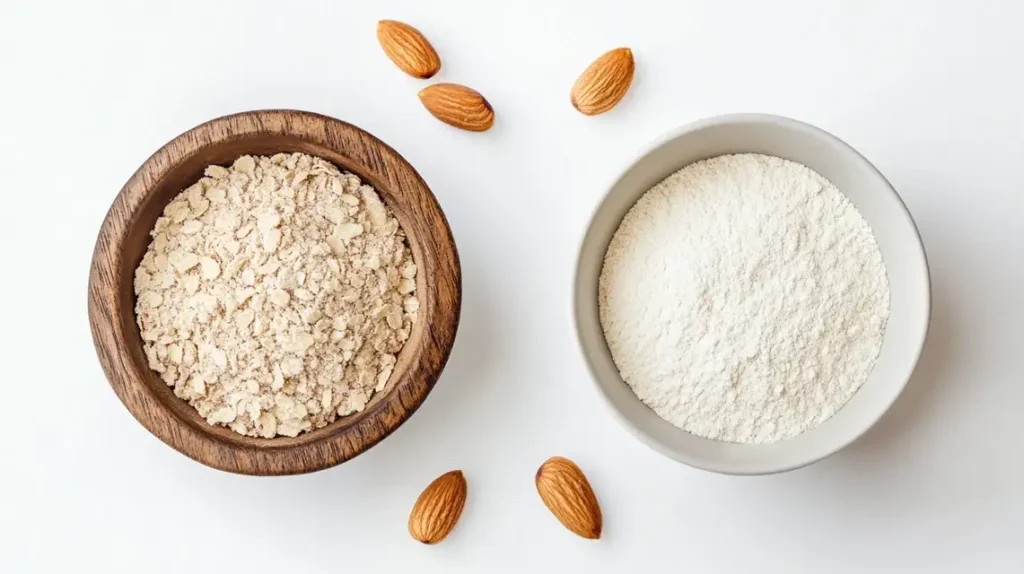When it comes to baking and cooking, Almond Meal vs Flour is a topic that sparks curiosity and confusion. Are they interchangeable? Understanding the key differences between Almond Meal vs Flour can help you make better choices for your recipes. Whether you’re aiming for perfect cakes or hearty breading, knowing when to use each is crucial.
Table of Contents
Understanding Almond Meal and Almond Flour
The debate over Almond Meal vs Flour often comes down to texture and use. Almond meal is made from whole almonds, including the skin, which gives it a coarse texture and nutty flavor. In contrast, almond flour is smoother and made from blanched almonds. Comparing Almond Meal vs Flour side by side helps you choose the right option for your dish.
What Is Almond Meal?
Almond meal is made by grinding whole almonds, including their skins. The result is a coarse, speckled flour-like powder with visible flecks of brown from the almond skins. Its texture is rustic and nutty, making it a great choice for recipes that call for hearty flavors.
If you’ve ever baked with almond meal, you might have noticed how it lends a slightly chunkier texture to recipes like muffins, cookies, or crusts. This is because it’s less processed than almond flour. Think of almond meal as the rugged sibling in the almond family—it’s wholesome and unpolished, but full of character.
What Is Almond Flour?
Almond flour, on the other hand, is all about smoothness and refinement. It’s made from blanched almonds—those with their skins removed—ground into an ultra-fine, almost powdery consistency.
You’ll notice almond flour is lighter in color, almost creamy white, because it doesn’t include the skins. This makes it ideal for delicate baked goods like cakes and macarons where texture matters. If almond meal is the rustic sibling, almond flour is the polished one who’s always dressed for success.
Explore what almond meal does in baking in our detailed guide: What Does Almond Meal Do in Baking?.
Key Differences Between Almond Meal and Almond Flour
While they’re both made from almonds, almond meal and almond flour aren’t twins—they’re more like cousins. Here’s a quick comparison to make things clearer:
| Feature | Almond Meal | Almond Flour |
|---|---|---|
| Texture | Coarse and grainy | Smooth and fine |
| Ingredients | Whole almonds (with skins) | Blanched almonds (no skins) |
| Best For | Rustic recipes, breading, savory dishes | Cakes, cookies, delicate pastries |
| Color | Speckled with brown flecks | Uniform creamy-white |
How Almond Meal and Almond Flour Are Made
Understanding how these two are produced gives insight into their unique characteristics. The process might seem simple, but tiny details make a big difference.
Production Process of Almond Meal
Almond meal is made by grinding raw almonds, including their skins, into a coarse flour. Since the almonds are used whole, the result retains the nut’s natural oils and fiber. This gives almond meal its signature coarse texture and nutty flavor.
Think of making almond meal like crushing crackers for a pie crust—it’s not about perfection but about creating a rough, usable base.
Production Process of Almond Flour
Creating almond flour is a bit more sophisticated. First, the almonds are blanched in hot water to remove their skins. Then, they’re ground into a fine, uniform powder. This extra step ensures almond flour is smoother and lighter than its counterpart.
Because it’s so fine, almond flour works perfectly in recipes where precision matters, like pastries that rely on airy textures.
Impact of Blanching on Texture and Color
Blanching doesn’t just affect the color of almond flour—it changes its entire character. Without the fibrous skin, the flour is less gritty, allowing it to blend seamlessly into recipes.
The skins in almond meal, however, add an earthy depth of flavor. Imagine the difference between peeling an apple for a pie or leaving the skin on. Each has its charm, but one is undeniably smoother.
Nutritional Comparison: Almond Meal vs. Almond Flour
Here’s where things get even more interesting. Both almond meal and almond flour are nutritional powerhouses, but they’re not identical twins here either.
Caloric Content and Macronutrients
Both almond meal and almond flour are rich in protein, healthy fats, and fiber. However, almond meal often has slightly more fiber due to the inclusion of almond skins.
| Nutrient | Almond Meal (per 1/4 cup) | Almond Flour (per 1/4 cup) |
|---|---|---|
| Calories | ~160 | ~150 |
| Protein | 6g | 6g |
| Fat | 14g | 12g |
| Fiber | 3g | 1g |
Notice how almond meal has a touch more fiber and fat, making it slightly more filling than almond flour.
Micronutrient Profiles and Health Benefits
Both almond meal and almond flour boast high levels of Vitamin E, magnesium, and antioxidants. These nutrients support heart health, skin elasticity, and even cognitive function.

Cooking and Baking with Almond Meal and Almond Flour
Almond meal and almond flour might both be derived from almonds, but they serve very different purposes in the kitchen. Let’s explore how each ingredient works in various recipes and whether you can swap them out for one another.
Best Uses for Almond Meal
Almond meal is a star in recipes that don’t require a perfectly smooth texture. It’s like the unsung hero in the kitchen—it may not steal the spotlight, but it adds a rustic charm to everything it touches.
Some of the best uses for almond meal include:
- Breading and Coatings: Its coarse texture makes it perfect for breading chicken, fish, or even vegetables. Think crispy, nutty crusts with every bite.
- Rustic Bakes: Almond meal shines in muffins, hearty cookies, or quick breads. Its texture lends a delightful crumb.
- Crusts: Use almond meal to create crunchy pie crusts or tart bases.
Almond meal is also fantastic for savory dishes. Ever tried using it as a topping for casseroles or mixing it into meatballs? Its versatility is unmatched.
Best Uses for Almond Flour
Almond flour is the smooth operator in the kitchen. Its fine, silky texture makes it the perfect choice for delicate baked goods and recipes where texture needs to be spot-on.
Here’s where almond flour works best:
- Cakes and Pastries: Light, airy cakes and macarons practically demand almond flour. It blends seamlessly into batters for flawless results.
- Pancakes and Waffles: Almond flour makes gluten-free breakfasts feel indulgent, with soft, fluffy textures.
- Binding Agent: Its fineness allows it to act as a binder in recipes like gluten-free bread.
Substituting Almond Meal for Almond Flour: Does It Work?
Can you use almond meal in place of almond flour? It depends on the recipe.
For rustic recipes like cookies or quick breads, swapping almond meal for almond flour often works just fine. The texture might be slightly chunkier, but the flavor will remain nutty and delicious.
However, when it comes to delicate recipes like macarons or light sponge cakes, almond meal can throw off the texture. The specks of almond skin can also alter the appearance of your final product.
Substituting Almond Flour for Almond Meal: Challenges and Tips
On the flip side, using almond flour instead of almond meal can be tricky in recipes where texture matters. Almond flour’s smoothness might not provide the same crunch or density that almond meal does.
If you’re set on making the swap, here’s a tip:
- Add a tablespoon of shredded coconut or a touch of cornstarch to mimic almond meal’s heartier texture.
Common Problems When Using Almond Meal and Almond Flour
One challenge when dealing with Almond Meal vs Flour is understanding their role in baking. Using almond meal instead of almond flour in delicate pastries can lead to dense, uneven textures. On the other hand, substituting almond flour for almond meal in breading or rustic recipes may leave you without the desired crunch. Mastering Almond Meal vs Flour substitutions is essential for perfect results.
Texture and Density Issues
Using almond meal or almond flour incorrectly can result in dense, crumbly baked goods. Why? Almond-based flours don’t contain gluten, the protein that provides structure in traditional baking.
To combat this, try the following:
- Combine almond flour with other gluten-free flours like tapioca or coconut flour for better structure.
- Add eggs or flaxseed meal to help bind your batter.
Flavor Considerations in Recipes
Almond meal and almond flour bring a distinct nutty flavor to recipes. While this is often a plus, it can overpower more subtle flavors.
To balance the flavor:
- Use mild, complementary ingredients like vanilla or citrus.
- Pair with bold spices like cinnamon or nutmeg to enhance the nuttiness.
Health and Dietary Considerations
One of the reasons almond meal and almond flour have gained popularity is their nutritional value and compatibility with various diets.
Gluten-Free Baking with Almond Meal and Almond Flour
For anyone avoiding gluten, these almond-based flours are a godsend. They’re naturally gluten-free, making them a staple in everything from cakes to pizza crusts.
If you’re new to gluten-free baking, here’s a quick tip:
- Don’t rely solely on almond flour. Mixing it with other gluten-free flours improves texture and prevents overly dense results.
Low-Carb and Keto Applications
Both almond meal and almond flour are darlings of the low-carb and keto world. They’re high in healthy fats and protein, making them perfect for carb-conscious diets.
Keto-friendly recipes like almond flour pancakes, keto bread, or fat bombs often rely on the smooth consistency of almond flour. Almond meal, with its higher fiber content, is great for heartier dishes like meatloaf or veggie burgers.
Popular Recipes Using Almond Meal and Almond Flour
Almond meal and almond flour are more than just versatile—they’re transformational in the kitchen. Whether you’re crafting sweet treats or savory dishes, these almond-based ingredients can elevate your recipes to new heights.
Almond Flour Pancakes and Desserts
Almond flour takes pancakes and desserts to the next level. Its fine texture blends perfectly into batters, creating light, fluffy, and melt-in-your-mouth results.
- Almond Flour Pancakes: Start your day with these tender, golden pancakes. They’re gluten-free, low-carb, and just as satisfying as the traditional version. Add a splash of vanilla and a sprinkle of cinnamon for a comforting twist.
- Almond Flour Brownies: Craving something indulgent? Almond flour brownies are dense, fudgy, and rich—perfect for chocolate lovers.
- Macarons: The quintessential almond flour dessert, these delicate French cookies rely on its smooth texture for their signature lightness.
Almond Meal for Savory Dishes
Almond meal holds its ground in savory recipes where a little texture goes a long way.
- Breading for Meats and Vegetables: Coat chicken or zucchini slices in almond meal for a crunchy, flavorful crust.
- Meatballs and Burgers: Replace breadcrumbs with almond meal for a gluten-free binder that doesn’t skimp on flavor.
- Savory Tart Crusts: Use almond meal to make a rustic crust for quiches or tarts.
Choosing Between Almond Meal and Almond Flour
When it comes to deciding between almond meal and almond flour, the choice boils down to texture, flavor, and the dish you’re making.
Factors to Consider When Selecting Ingredients
Before reaching for one or the other, ask yourself:
- What texture does the recipe call for? Smooth and airy recipes work best with almond flour, while hearty dishes benefit from almond meal.
- What’s the flavor profile? Almond meal’s nuttiness shines in savory dishes, while almond flour works in subtly sweet or delicate desserts.
Price and Availability Comparison
While both almond meal and almond flour are widely available, almond flour is often slightly pricier due to the extra step of blanching. However, many brands now sell both at reasonable prices in health food stores and online.
If you’re on a budget, you can even make almond meal at home by grinding whole almonds in a food processor. Just be sure not to overprocess them into almond butter!
Storing and Handling Almond Meal and Almond Flour
Proper storage is key to getting the most out of these almond-based ingredients.
Proper Storage Methods for Longevity
Almond meal and almond flour are both prone to spoilage due to their high oil content. To keep them fresh:
- Store them in an airtight container.
- Keep them in the refrigerator or freezer, especially if you live in a warm climate.
When stored correctly, they can last up to six months in the fridge or a year in the freezer.
Signs of Spoilage and How to Avoid Waste
If almond meal or almond flour smells rancid or has a bitter taste, it’s time to toss it. Here’s how to avoid waste:
- Buy smaller quantities if you don’t bake often.
- Label containers with the purchase date to track freshness.
FAQs
Can almond flour and almond meal be used interchangeably?
In some recipes, yes, but not always. Almond meal works better for rustic, hearty dishes, while almond flour is ideal for smooth, delicate baked goods.
Is almond flour healthier than almond meal?
Both are equally nutritious. Almond meal has more fiber due to the almond skins, while almond flour is slightly lower in calories.
Can I make almond meal or almond flour at home?
Yes! You can grind whole almonds for almond meal or blanched almonds for almond flour. Just use a food processor and pulse carefully to avoid making almond butter.
Why is almond flour so expensive?
The extra step of blanching and fine grinding increases the cost of almond flour compared to almond meal.
What’s the shelf life of almond meal and almond flour?
When stored in a cool, dry place, almond meal and almond flour last up to six months in the fridge or a year in the freezer.
Are almond meal and almond flour keto-friendly?
Absolutely! Both are low in carbs and high in healthy fats, making them excellent choices for keto baking.
Discover how to bake with almond meal as a substitute for flour: Can You Bake With Almond Meal Instead of Flour?.
Conclusion: Finding the Right Fit for Your Kitchen
So, does almond meal work the same as almond flour? The answer is—it depends on the dish. Almond meal brings a rustic, nutty charm to savory recipes and hearty bakes, while almond flour offers smoothness and refinement for delicate desserts.
Understanding their differences means you’ll always pick the right ingredient for your recipe. Whether you’re whipping up a batch of almond flour pancakes or crusting chicken with almond meal, these ingredients promise delicious, wholesome results.

Almond Meal vs. Almond Flour
Equipment
- Food Processor
- Airtight Container
Ingredients
Almond Meal
- 1 cup raw almonds with skins
Almond Flour
- 1 cup blanched almonds skins removed
Instructions
- To make almond meal: Place raw almonds with skins in a food processor and pulse until a coarse, grainy texture is achieved.
- To make almond flour: Place blanched almonds in a food processor and blend until finely ground into a smooth, powder-like consistency.
- Store in an airtight container in the refrigerator for up to 6 months.

